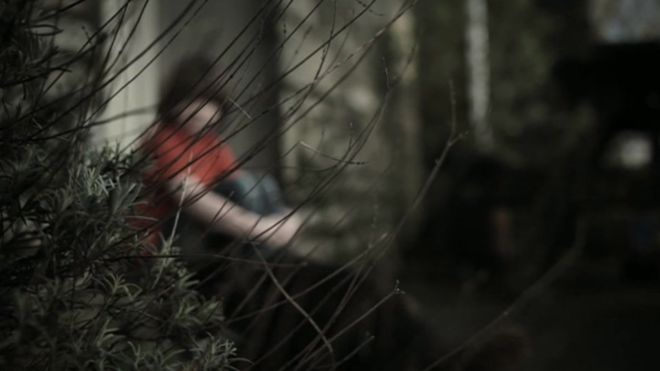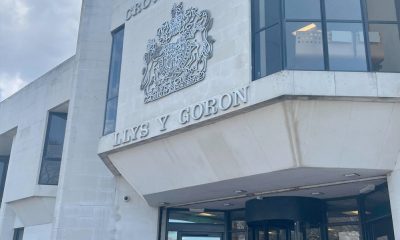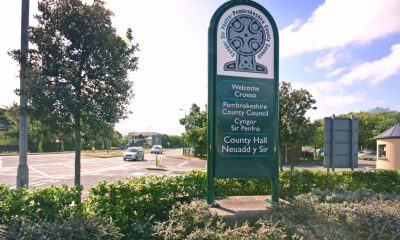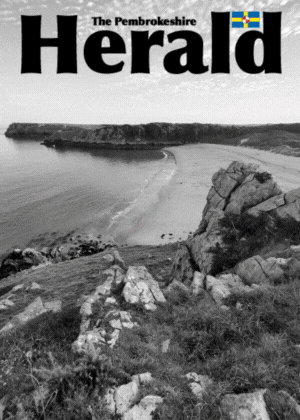News
Life sentence for depraved father after sexually abusing daughter

A PAEDOPHILE described by a Crown Court judge as having ‘psychopathic tendencies’ and a ‘devious, wicked, and flawed personality’ has been jailed for life after pleading guilty to 16 counts of rape and sexual assault in a catalogue of abuse directed against his own daughter.
The child’s mother, who suffers from what the court was told was ‘battered person syndrome’, received a ten year sentence for her part in years of abuse.
CHILD MIGHT NEVER RECOVER
The Court heard that the man had effectively groomed his wife, whom he met when she was 16, and controlled access to medication she required for a mental health condition. The woman, now in her 20s, was ordered to be detained in a psychiatric hospital for treatment.
On sentencing the pair at Swansea Crown Court, HHJ Geraint Walters QC ordered that the father, in his 50s, go to prison for a minimum of twelve years and was only to be released if and when it was determined that he did not pose a risk to children. Judge Walters observed it was possible that might never happen.
To protect their victim/daughter, the Court has ordered a blanket ban on reporting the parents’ names and the name of the west Wales town in which they perpetrated their appalling crimes.
HHJ Walters said that it was hard to see how their daughter could ever recover from the depravity inflicted upon her.
During her eight years in west Wales, the child never went to school, played outside, saw a cat or a dog or had a friend.
‘HOME SCHOOLING’ CONCEALED ABUSE
The husband’s ‘home-schooling’ of his daughter was only camouflage for effectively keeping her as a sex slave, said the Judge: “Not exactly locking her in a cellar but not far from it.”
There were padlocks on all the doors and the curtains were always kept closed.
The girl was never allowed out and, consequently, had never played with friends, or gone swimming. She had never seen Christmas lights and had no concept of a celebration.
Prosecuting Council Robin Rouch told the Court that the ‘tightly controlled home environment’ was created by the father to ‘systematically and regularly abuse’ his daughter without being discovered.
When police raided the couple’s home they found evidence of systematic, long-term child abuse inflicted on the daughter by both parents. Their investigation also revealed that the father had also abused a daughter of a previous marriage.
A spokesperson for NSPCC Cymru said: “The prolonged abuse – physical, sexual and emotional – suffered by this young victim is appalling and deeply disturbing.
“The role a parent is to protect and support their child, but the couple in this case simply saw in their daughter an opportunity to inflict repeated sexual attacks.”
CALL FOR HOME SCHOOLED REGISTER
The case has reignited calls for home-schooled children to be registered by local authorities and for more active monitoring of the welfare of those children who received education outside traditional schooling.
Mid and West Wales AM Helen Mary Jones said: “The vast majority of home-schooling is a good choice made by good parents, but we know there is a small minority where things go wrong and I believe we should have those children registered – we should know they’re being home-schooled.
“I also think an annual medical check – it’s quite common when children are in primary school, they may see the school dentist or the school nurse – as a precaution, it would be really useful.”
The case has drawn comparisons with the case of Dylan Seabridge, who was effectively invisible to social and health services and who died of scurvy whilst being ‘home-schooled’ in 2011.
Dylan Seabridge – who lived in a remote Pembrokeshire community with his parents and older sibling – died of scurvy in December 2011 aged eight-years-old.
Criminal proceedings against Dylan’s parents in relation to their son’s death were halted over concerns about his mother’s mental health.
There were no allegations of sexual abuse in the Seabridge case.
GOVERNMENT TOO SLOW TO ACT
An independent report into the death of Dylan Seabridge written by Gladys Rhodes White OBE, a national expert in safeguarding and child protection, recommended that the Welsh Government change the law so that the details of all elective home educated children are kept on a register and that they are seen and spoken to and their wishes recorded on an annual basis.
At present there is no such requirement and the law does not state any general requirement for parents to inform the education directorate if their child or children were never on a school roll.
Home education’s supporters say that registration would be an unwarranted intrusion into families’ lives. In addition they claim that there is no evidence to support a contention that home-schooled children are at a greater risk of neglect than those attending a state school. There is also a distinction between those children who are home-schooled and those who are ‘kept at home’ for other reasons.
Children’s Commissioner for Wales Sally Holland disagrees: “I’ve been calling for the government to act in a stronger way, so have all the directors of education in Wales, all the directors of social services and the government’s own independent safeguarding board.
“For me the pace of change has been too slow and hasn’t been strong enough to ensure every child gets the right to an education to be safe and to have their say.”
A Welsh Government spokesman said: “Earlier this year the education secretary announced plans to consult on regulations that will require local authorities to establish a database to identify children not on a school register.
“We are also reviewing and updating national protection procedures to examine how social services and education practitioners can work together and share information to ensure children who are home-schooled get the support they need.”
Crime
Emergency bags rolled out to support domestic abuse victims across Dyfed-Powys

Thirty packs provide immediate help for families fleeing dangerous situations
A NEW initiative aimed at supporting victims of domestic abuse has seen thirty emergency bags distributed for use across the Dyfed-Powys Police area.
The bags, which contain essential items including toiletries, non-perishable snacks and emergency supplies, are designed to offer immediate practical support to individuals and families forced to flee abusive situations, often with little or nothing.
The scheme forms part of the Police and Crime Commissioner’s wider commitment to improving outcomes for victims and is being delivered in partnership with Dyfed-Powys Police and Dal i Godi, the commissioned Independent Domestic Violence Adviser (IDVA) service.
Dal i Godi provides specialist support to victims at high risk of serious harm, including safety planning and advocacy through the criminal justice process.
Police and Crime Commissioner Dafydd Llywelyn said the initiative was already proving its value.
“This is an incredible initiative that I’m proud to support,” he said. “It provides meaningful help to those experiencing trauma and reflects our ongoing work to put victims first.
“Within just a few days of the bags being distributed to the Dal i Godi service, one was given to a victim fleeing a domestic abuse situation, along with a children’s pack to support their young family. That shows just how essential this support can be and how quickly it can make a difference.”
Detective Chief Inspector Llyr Williams, from the Dyfed-Powys Police Vulnerability Hub, said the emergency bags could provide a vital lifeline at critical moments.
“These emergency bags offer support at some of the most difficult moments in a person’s life,” he said.
“The contents provide immediate comfort, dignity and practical help for those leaving their homes in crisis. While simple, they represent an important first step towards safety and recovery.
“We are proud to be working with partners across the Dyfed-Powys area to ensure this support reaches people when they need it most.”
Anyone experiencing domestic abuse, or concerned about someone else, is encouraged to seek help. In an emergency, call 999.
Domestic abuse can also be reported online via Dyfed-Powys Police.
Support services available include Victim Support Dyfed-Powys, which offers free and confidential help to anyone affected by crime, whether or not it has been reported, and Dal i Godi, which provides specialist IDVA support for high-risk victims.
The Live Fear Free Helpline offers 24-hour support for those experiencing domestic abuse or sexual violence across Wales.
If you or someone you know is a victim of domestic abuse, please consider reporting it. If you are in danger or need support right away, please call 999.
You can report domestic abuse through the online crime reporting service here: Report domestic abuse | Dyfed-Powys Police.
Support is also available via the below support services:
Victim Support Dyfed-Powys
Free, independent support for anyone affected by crime in the Dyfed-Powys area, whether or not it has been reported to the police.
0300 123 2996
Dal i Godi (IDVA Service)
Specialist support for victims of domestic abuse at high risk, offering safety planning, emotional support, and advocacy with agencies such as police and courts.
01267 221194
Live Fear Free Helpline
24/7 support for anyone experiencing domestic abuse or sexual violence.
0808 80 10 800 | Text 07860 077333
News
Welsh-language school praised for ‘happy, proud and friendly community’

Estyn highlights strong leadership, positive attitudes and a clear curriculum vision at Ysgol Bro Preseli
A WELSH-medium all-age school in Crymych has been praised by inspectors for fostering a “happy, proud and friendly community,” according to a recent Estyn report.
Inspectors said pupils at Ysgol Bro Preseli show pride in their local area, thrive both academically and socially, and are well prepared for the next stages of their learning.
The school currently has 932 pupils on roll, including 118 in the sixth form, and has operated as an all-age school since 2022.
Estyn found that most pupils demonstrate extremely positive attitudes to learning, treat staff with respect, and listen carefully to the contributions of their peers.
The report also notes that, in almost all cases, teachers show strong subject knowledge. Inspectors highlighted the close and supportive relationships staff build with pupils, alongside the creation of a safe learning environment where pupils are not afraid to make mistakes.
It states: “As a result of a clear strategic direction and detailed planning, teachers provide beneficial practical activities that allow pupils to develop purposeful oracy, reading and writing skills in language sessions and across the other areas of learning and experience.”
Inspectors also praised the school’s clear curriculum vision, rooted in its motto Gwreiddiau a Gorwelion (Roots and Horizons).
“Leaders and teachers provide a coherent curriculum and learning experiences that bridge the primary and secondary sectors effectively,” the report said. “Staff plan stimulating activities and experiences for pupils to learn and deepen their understanding within the areas of learning and experience. This contributes positively to the sense of belonging that permeates the whole curriculum of Ysgol Bro Preseli.”
Headteacher Rhonwen Morris said the report was a reflection of the collective effort across the school community.
“As a successful all-age Welsh-medium school, we are delighted that the report recognises our commitment to excellence and the unique identity that makes Ysgol Bro Preseli so special,” she said.
“Since becoming an all-age school in 2022, our cohesive leadership team and governing body have focused on building a strong foundation based on our values of Welsh ethos, kindness, community and responsibility.
“The report highlights the excellent strategic work of staff at all levels, which is a testament to the shared dedication and vision that drives our school forward.
“It is gratifying that the report reflects what we continuously aim to achieve day in and day out. This achievement belongs to our entire community — staff, pupils, parents and governors — and together we will continue to build on this success and provide the very best education for every pupil.”
Charity
Welsh opticians raise £1,600 for people experiencing homelessness

SPECSAVERS Pembroke Dock has helped raise £1,600 to support people experiencing homelessness this winter, with all funds going to The Wallich’s winter appeal.
Thirteen stores from North, South and West Wales donated £1 for every customer feedback form completed during November to help The Wallich, Wales’ largest homelessness and rough sleeping charity, continue its vital work.
Supporting more than 8,000 people experiencing or at risk of homelessness across the nation each year, The Wallich runs around 100 diverse projects across 20 local authorities to provide hope, support and solutions to end homelessness.
Funds raised by Specsavers will go directly to the Wallich’s Flexible Assistance Fund, which provides small but vital emergency grants. The grants support people at crucial turning points, helping cover essential costs such as phone credit, rent or food shops.
This initiative is a continuation of Specsavers’ wider homelessness programme, which sees over a hundred Specsavers stores and Home Visits services hold out-of-hours or pop-up clinics and invite people affected by forms of homelessness to use their services for free.
Specsavers’ North Wales regional relationship manager, Martin Lawrence, who helped organise the fundraiser, says: ‘We’re really proud to be supporting The Wallich’s winter appeal at a time when support is needed most.
‘Homelessness affects people in every community and as locally owned and run businesses, Specsavers stores are committed to raising awareness of the issue and supporting people through their toughest moments.
‘We’re excited to build on the success of this fundraiser and strengthen our partnership with The Wallich in the new year.’
Louisa Turner, head of fundraising at The Wallich, adds: ‘Winter can be an incredibly difficult time for people experiencing homelessness and this support from Specsavers will make a real difference.
‘The funds raised will help provide emergency grants at critical moments – whether that’s putting food on the table, helping someone stay connected with their loved ones or preventing someone from losing a safe place to live.
‘This kind of support creates vital turning points and helps people move towards a safer, more secure future.’
Specsavers works year-round with homelessness charities including Crisis, Vision Care and The Big Issue, to improve access to healthcare and advocate for policy change – ensuring people experiencing homelessness can receive free eye tests, glasses and hearing checks.
To find out more about Specsavers or to book an appointment at your local store, visit: https://www.specsavers.co.uk/stores.
-

 Crime3 days ago
Crime3 days agoMilford Haven man jailed after drunken attack on partner and police officers
-

 News6 days ago
News6 days agoDyfed-Powys Police launch major investigation after triple fatal crash
-

 Crime3 days ago
Crime3 days agoTeenager charged following rape allegation at Saundersfoot nightclub
-

 Crime4 days ago
Crime4 days agoMan charged with months of coercive control and assaults
-

 Crime4 days ago
Crime4 days agoMan sent to Crown Court over historic indecent assault allegations
-

 Crime6 days ago
Crime6 days agoMan spared jail after baseball bat incident in Milford Haven
-

 Crime4 days ago
Crime4 days agoMilford Haven man admits multiple offences after A477 incident
-

 Crime4 days ago
Crime4 days agoWoman ‘terrified in own home’ after ex breaches court order

































